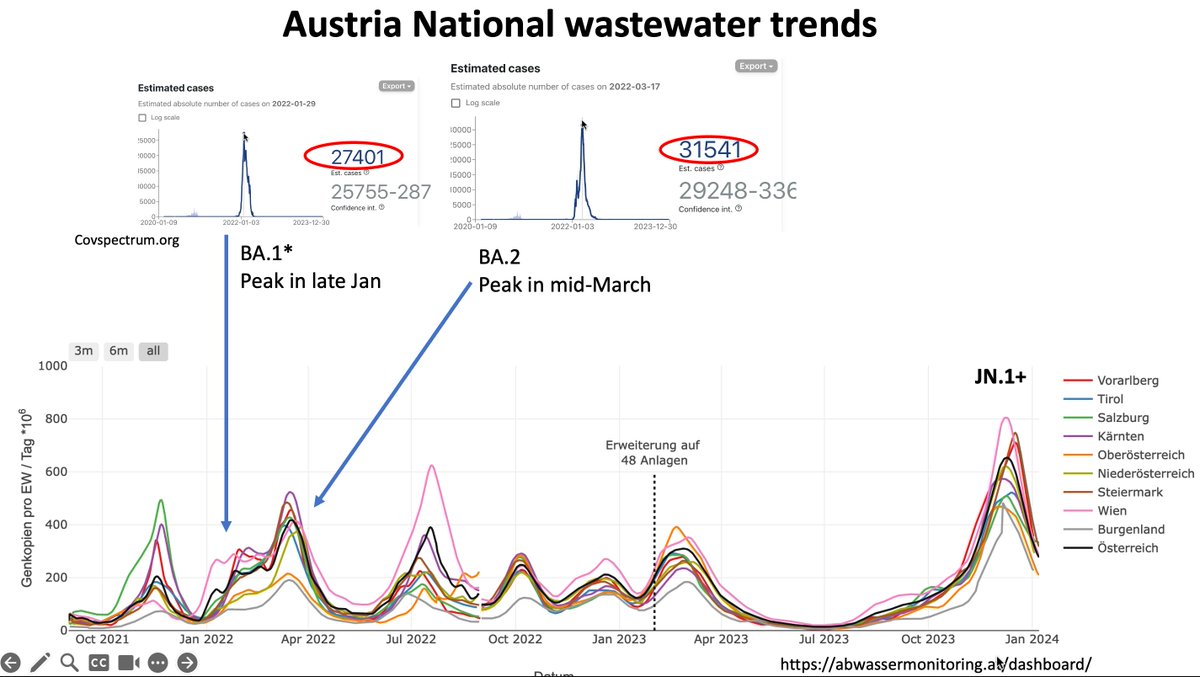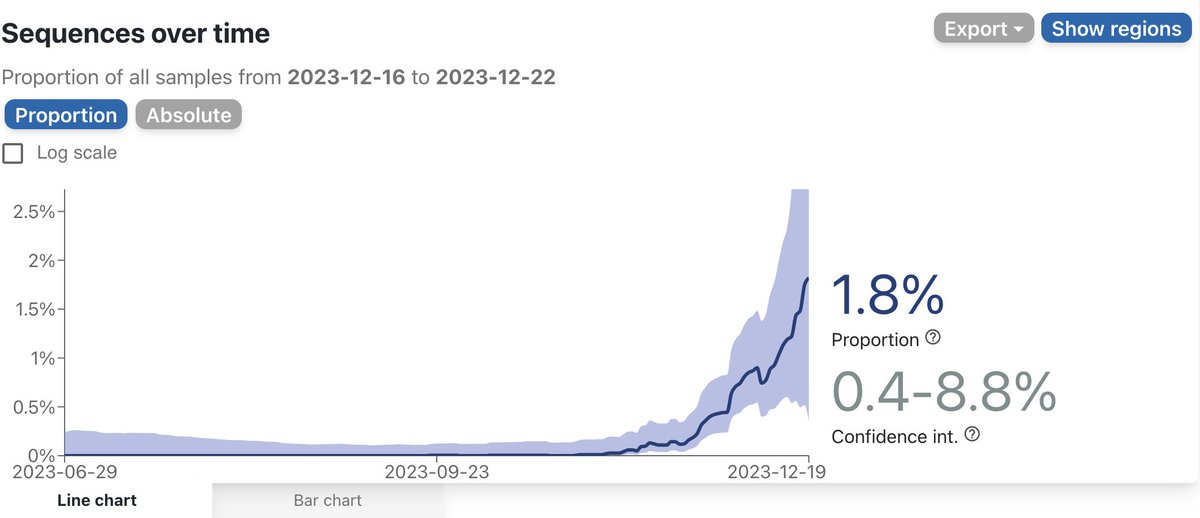It’s pretty clear the most sweeping SARS-CoV-2 lineages to date have been Delta, BA.1, and now JN.1.
Fun fact: as far as I am aware, our laboratory (with our collaborators) was the first to detect all three of these lineages from US wastewater.
Why were we always first?
1/
Fun fact: as far as I am aware, our laboratory (with our collaborators) was the first to detect all three of these lineages from US wastewater.
Why were we always first?
1/
To explain, we need to talk about the different ways that wastewater sequencing is performed.
For sequencing, most wastewater groups do what it is called whole genome sequencing (WGS). This is the same technique that is used with all clinical samples.
2/
For sequencing, most wastewater groups do what it is called whole genome sequencing (WGS). This is the same technique that is used with all clinical samples.
2/
Think of this as the ‘jigsaw puzzle’ technique. With WGS, the entire SARS-CoV-2 genome is sequenced in small bits, and then the sequence bits (like pieces of a jigsaw puzzle) are fed into a computer that assembles them back into a whole puzzle.
3/
3/

WGS on wastewater gets a bit more complicated because there isn’t just one puzzle.
You basically end up mixing together some of the pieces from hundreds of very similar jigsaw puzzles.
It becomes impossible to fully reconstruct the different puzzles.
4/
You basically end up mixing together some of the pieces from hundreds of very similar jigsaw puzzles.
It becomes impossible to fully reconstruct the different puzzles.
4/
However, if you have the pictures of what the starting puzzles could have been, you can get a pretty good idea of which puzzles are in the mix. A team at SCRIPPS maintains a fantastic program called Freyja for making sense of this data. @josh__levy
5/github.com/andersen-lab/F…
5/github.com/andersen-lab/F…
Nonetheless, using the jigsaw puzzle approach, it is difficult recognizing if something new is in a sample because there is no corresponding 'picture'.
It’s not impossible to find them, but it’s pretty difficult, particularly if the new thing is present at really low levels.
6/
It’s not impossible to find them, but it’s pretty difficult, particularly if the new thing is present at really low levels.
6/
Back in 2020 when we started doing wastewater sequencing in Missouri, Freyja did not exist, and there were no standard protocols for WGS on wastewater. So we had to come up with our own approach.
7/
7/
We’ll call this the ‘facial recognition’ method. Because I knew from work on other Coronaviruses that the most frequent and consequential changes occur in the receptor binding domain (RBD) of the Spike protein, I decided to focus on that, rather than the whole genome.
8/
8/

This preprint from Jesse Bloom’s lab from late 2020 had a big influence on my thinking. @jbloom_lab
9/biorxiv.org/content/10.110…
9/biorxiv.org/content/10.110…
We started sequencing the RBD from WW in late 2020 (we sequence a few other spots too now), but at the time we were using the enzyme we had on hand (taqpath), which had a very high error rate. (In 2020 reagents were in short supply). This made the readout rather murky.
10/
10/

There were tons of mutations, so it was hard to sort out which were real. Rather than ask what mutations were present, we asked ‘what mutations appeared to together on the same strand of RNA’. Then the output became obvious.
11/
11/

Although the B.1.1.7/Alpha variant (UK variant at the time) essentially had not been reported in Missouri yet, we found Alpha at low levels in 15 out of 23 sewersheds we tested.
12/health.mo.gov/news/newsitem/…
12/health.mo.gov/news/newsitem/…
Shortly after that we switched to an enyzyme that makes much fewer errors, but we continued to focus on not just what mutations were present, but what mutations were together (termed linkage). We published a paper on our approach and software.
13/doi.org/10.3390/v13081…
13/doi.org/10.3390/v13081…
Then a few months later we detected another new variant, but this one wasn’t so subtle. The first detection was on May 11, but it was in virtually every sewershed in the state within 2 weeks. This was the start of the US Delta wave.
14/
14/

Someone might have detected Delta in wastewater from the US before we did, but if they did, I am not aware of it.
15/
15/
In addition to sequencing wastewater from Missouri, we were also collaborating to sequence NYC’s wastewater in 2021-22. This was where we detected the next big lineage at a low level on November 21, 2021. The start of the Omicron wave.
16/cdc.gov/mmwr/volumes/7…
16/cdc.gov/mmwr/volumes/7…
The sample containing Omicron was collected the week before Omicron was announced to the world. The lineage stuck out like a sore thumb, but ironically, if we hadn’t heard about the reports from South Africa, we would have thought it was another cryptic lineage.
17/
17/

More recently we have also been collaborating with colleagues at the GVSU Cell and Molecular Biology Department in Michigan.
They do all the work, but we run the sequencing together and use the same software for analysis.
We do the same with @ELwollants in Belgium.
18/
They do all the work, but we run the sequencing together and use the same software for analysis.
We do the same with @ELwollants in Belgium.
18/
In one of the Michigan samples collected on Sept. 7 of this year there was a surprising new lineage. A BA.2.86 lineage with an extra change that would evade Class 1 neutralizing antibodies (L455S). I had been watching for that.
This lineage was later named JN.1.
19/
This lineage was later named JN.1.
19/

The health department was notified, but at the time there was no evidence that this lineage was going to be trouble, just my educated hunch.
There were only 4 sequences then, from across Europe.
This prompted my ‘oh shit’ post in late Sept.
20/
There were only 4 sequences then, from across Europe.
This prompted my ‘oh shit’ post in late Sept.
20/
https://twitter.com/SolidEvidence/status/1707099377641415036
What was interesting about the Michigan detection is that it didn’t persist. It was probably a traveler who brought it back from Europe but didn’t spread it on. This probably happened lots of times in August/September, we were just the ones to catch it.
21/
21/
The first patient in the US reported to have a JN.1 was a traveler, reported on September 29 (3 weeks later). The first case of community spread in the US was not reported until October 10. After that it took off.
22/
22/

So why is it that we were the first to detect all 3 of these lineages even though our surveillance only covers a tiny fraction of the country?
Maybe we’re just lucky.
Or maybe, our method is just a little bit better at detecting novel lineages?
23/
Maybe we’re just lucky.
Or maybe, our method is just a little bit better at detecting novel lineages?
23/
To date we have sequence well over 10,000 samples using this technique. It’s fast, cheap, sensitive, and fairly quantitative. This image is the data from MO.
Unfortunately, none of this data is represented on the NWSS wastewater variant monitoring at this time.
24/
Unfortunately, none of this data is represented on the NWSS wastewater variant monitoring at this time.
24/

NWSS only accepts WGS at this time, but I know they are working on accepting our method too.
Meanwhile, some groups seem to think of our method as inferior since NWSS doesn’t accept it, which is kind of a bummer.
@amylizk @RoryMWelsh
25/25cdc.gov/nwss/rv/COVID1…
Meanwhile, some groups seem to think of our method as inferior since NWSS doesn’t accept it, which is kind of a bummer.
@amylizk @RoryMWelsh
25/25cdc.gov/nwss/rv/COVID1…
• • •
Missing some Tweet in this thread? You can try to
force a refresh















